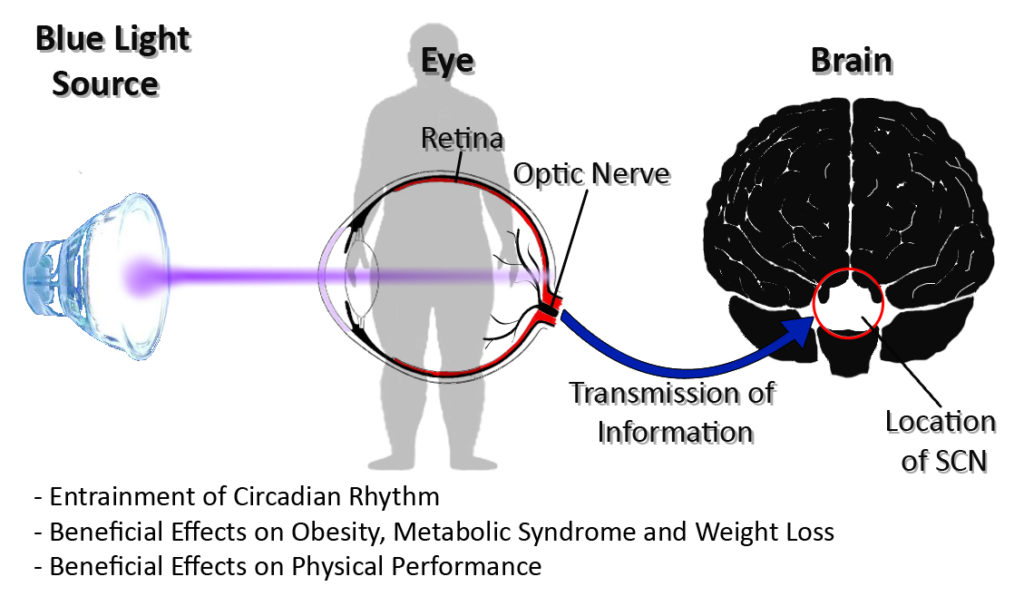
Further beneficial Effects of Light on Human Health and Performance
04.04.2017 / Scienceandmore / Category: Human Biology
The human eye (mammalian in general) holds retinal photoreceptors that have image forming and non-image forming functions. Cones and rods are mainly activated in image forming processes, whereas intrinsically-photosensitive retinal ganglion cells (ipRGC), which contain melanopsin, convey non-image forming light perception. Research in visually blind study participants, whose rods and cones did not show functional response, found a blue light effect on brain activity (measured by fMRI and EEG) during an auditory cognitive task, and, intriguingly, enhanced alertness upon blue light exposure. The researchers, therefore, proposed that the observed brain activity is mediated by melanopsin-containing ipRGCs.
In a previous blog post, the beneficial effects of blue and white light exposure on alertness and cognitive functions have been discussed (Beneficial Effects of Bright Daylight and Blue Light on Human Performance). Due to its important function in regulating the circadian clock, light exposure has also been investigated for its beneficial effects on weight loss, metabolic syndrome and physical performance.
Circadian Rhythm and Obesity, Metabolic Syndrome and Time-Restricted Eating
Obesity and metabolic syndrome are characterised by several physical manifestations. The decisive ones are central obesity, where high level of fat are located inside the abdomen (intra-abdominal) rather than beneath the skin (subcutaneously), elevated triglyceride levels and reduced HDL cholesterol, reduced glucose tolerance, as well as increased level of markers that indicate inflammation and reduced levels of anti-inflammatory markers. Unfortunately, metabolic syndrome already became a worldwide public health concern that affects a high percentage of people between 25 and 60. It is associated with a 2.3-fold increased risk to suffer from cardiovascular disease and a 2.4-fold increased risk to die due to cardiovascular disease.
On a physical level, the development and maintenance of obesity and metabolic syndrome are affected by choice of diet, overall caloric intake and physical inactivity. Interestingly, studies in mice and rats showed that the time of eating seems to impact the development of metabolic syndrome dramatically. When rats were fed a high fat diet but could only eat during the time of day when rats are active – called time-restricted feeding-, which is at night, they neither develop obesity, fatty liver, nor did they show high levels of insulin in the blood or increased inflammation, contrary to mice that could eat whenever they wanted. Surprisingly, the amount of calories that were consumed by rats of both groups was essentially the same. Also, the onset of obesity in rats that had access to food whenever they wanted was corrected by time-restricted feeding, which came as a big surprise and emphasises the importance of eating time and duration.
Research showed that the circadian rhythm is linked to the metabolism and its activity. Mice that had an impaired circadian rhythmicity, due to mutations in circadian clock genes, were prone to obesity and metabolic syndrome, and showed increased blood glucose, cholesterol and triglyceride levels. Based on these findings, the influence of light exposure at night on mice was investigated. Research found increased body mass in mice that were exposed to constant light or dim light during the night, which is the time of activity for mice, compared to mice that were exposed to normal day/night cycles. The mice in unnatural light conditions also showed impaired glucose tolerance, which in combination with increased body mass was interpreted as a pre-diabetic state. The detrimental effects on health occurred as early as one week after the unnatural light conditions were applied. It was also observed that mice that were exposed to dim light at night consumed significantly more food during the light phase, i.e. the time of their inactivity, compared to mice that were exposed to day/night cycles.
This effect of altered eating habits on weight gain was then further investigated. When mice that lived in day/night cycles were fed only at night, they did not change their body masses or fat percentages. When mice in day/night cycles were, however, fed during their inactive phase, i.e. the day, or had access to food whenever they wanted, they gained weight and fat.
Overall, these study results suggest that unnatural light conditions uncoupled activity and food consumption, and resulted in metabolic changes. This was suggested at least for mice. The researchers hypothesised an involvement of melatonin and melatonin rhythmicity in this alteration. It was found that mice that lived in constant light had blunted melatonin rhythms during the night, in combination with visceral adiposity (intra-abdominal fat accumulation). This increased fat deposition was, however, rescued by administration of melatonin.
In human studies it is harder to distinguish the actual effects of time-restricted feeding from other factors. Nevertheless, it was suggested that in the course of a weight loss diet, when study participant consumed their main meal later during the day, weight loss was less compared to participants who consumed their main meal earlier. Night time eating is probably a common and widely-known reason for fat gain and obesity, as well as, which is less-known, a reason for a disruption of the circadian rhythm. Light from screens of computers and electronic device, which emit an increased amount of blue light that, in turn, affects the rhythmicity of the circadian clock, have already been suggested to increase the risk to suffer from obesity, diabetes, and metabolic disorders. Linked to the disruption of the circadian rhythm, shift work or jet lag, where the subjective night phase is interrupted by light, was found to disrupt the timing of feeding and led to weight gain in rats. When, however, the simulation of shift work and jet lag was accompanied by time-restricted feeding to the active phase, the rodents did not gain weight. Studies in humans showed that a 12 hour shift in rhythm, which occurs by crossing several time zones, resulted in decreased blood leptin levels, and high blood sugar and insulin levels (hyperglycaemia and hyperinsulinemia). Leptin is a hormone that inhibits the sensation of hunger! This indicates the high importance of food consumption during the time of natural activity instead of inactivity in terms of health.
These findings in rodents and humans inferred a possible effect of targeted light exposure on weight loss. A study in overweight women (BMI 25 – 30) who did not exercise showed a mild effect of blue-enriched white light (1,300 lux) exposure in the morning for 45 minutes on weight loss. Overall, the body mass of the participants did not change, but they lost on average 0.35 kg of fat in three weeks, suggesting that blue-enriched white light affects body composition. The light-exposed group reported reduced appetite compared to the group that was not exposed to light. The researchers argued that light-mediated release of serotonin and norepinephrine in the brain and blood could be responsible for this appetite-supressing effect.
More significant, a combination of calorie-reduced diet and 30 min minute walk three times a week with daily exposure to daylight (10,000 lux) for 30 minutes resulted in an average loss of 8.6 kg body mass in overweight participants in two weeks, and only 2.9 kg when the participants were exposed to dim light (500 lux) for 30 minutes.
Taken together, results from animal and human studies suggest that eating during the natural active phase and an uninterrupted circadian rhythm have beneficial effects on the health. Light exposure in the morning may also modulate the metabolism and body composition.
Beneficial Effects of Blue Light on Physical Performance
During the day, physical performance improves towards afternoon and peaks in the late afternoon and early evening. Several studies investigated the effect of light exposure on human physical performance, but the results were inconsistent. However recently, a study was carried out that considered the individual internal time of the participants and exposed them to bright white light two hours prior and during a 40 minute cycling exercise. The researchers found improved performance on the bicycle ergometer that was accompanied by elevated heart rate, increased blood lactate levels and greater subjective exertion. Crucial was that the exercise was performed approximately 14.5 hours after the individual mid-sleep of the participants. Here, bright white light exposure improved performance compared to exercising approximately 11.5 hours after mid-sleep. These results indicate a relatively small timeframe when bright white light could contribute to performance enhancement.

References
Ekström, J.G. and Beaven, C.M. (2014) Effects of blue light and caffeine on mood. Psychopharmacology. 231, 3677-3683.
Kantermann, T., Forstner, S., Halle, M., Schlangen, L., Roenneberg, T., Schmidt-Trucksäss, A. (2012) The Stimulating Effect of Bright Light on Physical Performance Depends on Internal Time. PLoS ONE 7(7), e40655.
Maury, E., Hong, H.K., Bass, J. (2014) Circadian disruption in the pathogenesis of metabolic syndrome. Diabetes Metab. 40(5), 338-346.
Vandewalle, G., Collignon, C., Hull, J.T., Daneault, V., Albouy, G., Lepore, F., Phillips, C., Doyon, J., Czeisler, C.A., Dumont, M., Lockley, S.W., and Carrier, J. (2013) Blue Light Stimulates Cognitive Brain Activity in Visually Blind Individuals. Journal of Cognitive Neuroscience. 25(12), 2072-2085.
Fonken, L.K., Workman, J.L., Walton, J.C., Weil, Z.M., Morris, J.S., Haim, A., and Nelson, R.J. (2010) Light at night increases body mass by shifting the time of food intake. PNAS. 107 (43), 18664–18669.
Danilenko, K.V., Mustafina, S.V., Pechenkina, E.A. (2013) Bright Light for Weight Loss: Results of a Controlled Crossover Trial. Obes Facts. 6:28-38.
